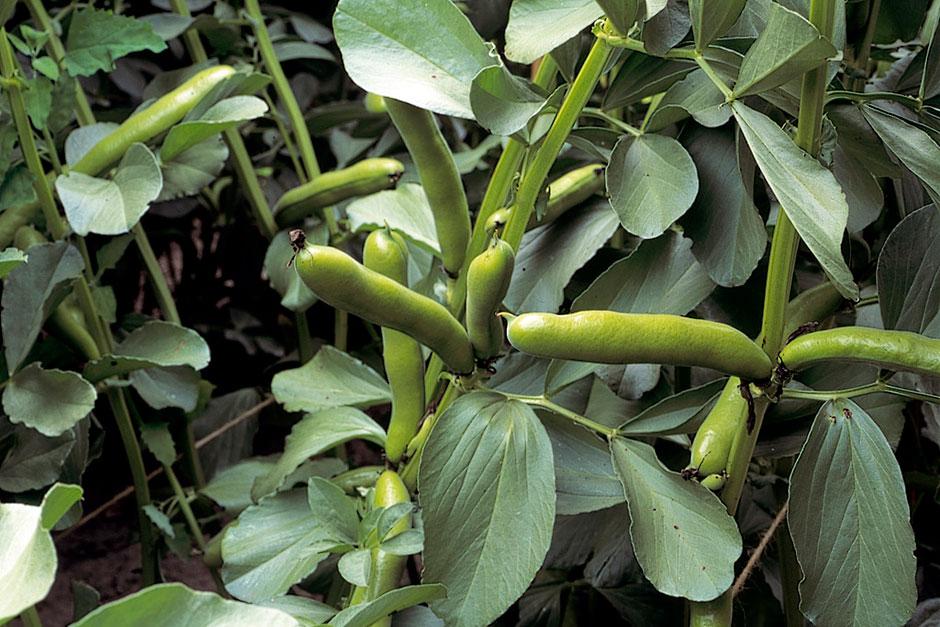Broad beans
Broad beans are rich in protein and high in riboflavin and vitamin C

- Season
- Autumn
- Name
Vicia fabaVicia = Latin for leaves like a vetch, faba = cultivated or farmed
- Common Name
- Broad beans
- Description
Broad beans are a good crop to sow in the autumn so that you can have an early harvest of beans in May and June – delicious.
- History
Broad beans are thought to originate in the Middle East and are a crop of ancient origin. Evidence has been found of their cultivation since at least 4500 BC. Today they are grown all over the world but are most popular in China. It is also known that in the Roman Senate the beans were used to vote, white bean for yes and black bean for no.
- Interesting Facts
-
Generally just the beans are eaten but if harvested young, the pods may also be eaten, and even the tips of the foliage are useable as greens
-
The stems are square not the usual round as with most plants.
-
Broad beans are one of the easiest plants to grow providing the soil is free draining and never waterlogged.
-
It's a good idea to dig in some organic matter, such as compost, in the autumn before sowing the beans in the ground to make sure you get a bumper crop.
-
You can sow the beans into pots and then transplant the young plants into the ground in the spring. This is a good idea if your soil is poorly drained.
Growing Tips
When to grow
-
You can sow broad beans in October and November if you use a hardy bean variety such as 'Aquadulce'.
-
Protect the seedlings from frost by using a cloche. Sowing in autumn means an earlier summer harvest of beans in May and June.
-
You can also sow most varieties of broad beans in the spring; see details on the seed packet for further information.
Make a cloche
You will need:
-
An empty clear plastic large drinks bottle
-
An adult with scissors
How:
-
Remove the lid and ask an adult to cut the bottle in half across the middle of the bottle.
-
You now have two individual cloches to place over your seedlings in the ground or in a pot.
How to grow
Indoors
-
Broad beans prefer to be planted in the position where they are to grow, but can be planted in individual pots during the autumn and transplanted in to the ground in the spring.
-
Fill a 9cm pot with multipurpose compost almost to the top, make a hole twice the width of your thumb and place the bean in tap the pot on the table or ground three times and your bean will be covered up.
-
Remember to water.
Outdoors
-
Sow broad beans either in the autumn (Oct–Nov) or in spring (Feb–April) at a depth of 5cm, spacing the beans 20cm apart.
-
Plant in staggered or zigzag rows 20cm apart as the plants can help to support each other.
-
It's a good idea to use canes or stakes and string to avoid the plants flopping over when they are in crop.
-
Pinch out the top 7cm of the plant (growing tip) once the first beans begin to form, to encourage an earlier bean harvest and to reduce black fly.
Watering
Broad bean plants need plenty of water when they are in flower to make sure that you get a good crop. Water the beans twice at the start of flowering and again two weeks later; making sure the soil is well soaked.
Harvesting
-
Begin picking the beans when they are about 7cm long, both the bean and pod can be boiled and eaten at this stage.
-
Once you can begin to see the beans through the pods then pick beans for shelling and discard the pods.
-
Look inside the pods carefully when you harvest the beans and feel the fluffy bed that the beans are resting in. The scar on each bean should be white or green not brown. The beans can be eaten raw in salads or cooked.
-
Once harvested, the bean plants can be pulled up and added to the compost bin. You can then use the space to grow another crop.
Pests and disease problems
Black bean aphid is the major pest of beans, pinching out the growing tips once beans begin to form will reduce attack. Spraying with an oil or fatty acid (soap) based insecticide recommended for edible plants will reduce their numbers but it may have to be done several times.
Nibbled leaves of seedlings is a sign of pea and bean weevil – covering the plants with fleece will help the beans outgrow this pest.

